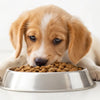How Much Dry Dog Food for a 70 Pound Dog: A Comprehensive Feeding Guide
- Houndsy
Table of Contents
- Introduction
- Factors Affecting How Much to Feed Your Dog
- Recommended Feeding Guidelines for a 70 Pound Dog
- The Importance of Portion Control and Quality Ingredients
- Adjusting Feeding Amounts Based on Individual Needs
- Conclusion
Introduction
Did you know that nearly 59% of dogs in the United States are considered overweight or obese? This startling statistic underscores the importance of understanding how to properly feed our furry companions. As responsible pet owners, we want to ensure our dogs receive the right nutrition to maintain their health and vitality. If you have a 70-pound dog, you might be wondering, "How much dry dog food should I be feeding them?"
In this blog post, we will delve into the factors that influence the correct amount of food for a 70-pound dog, including age, activity level, and the type of food you choose. By the end of this article, you will have a clear understanding of how to determine the right portion sizes for your pet, ensuring they thrive without the risk of obesity or nutritional deficiencies.
We'll cover the following key areas:
- Factors affecting feeding amounts
- Recommended feeding guidelines for a 70-pound dog
- The importance of portion control and quality ingredients
- How to adjust feeding amounts based on your dog's individual needs
Let’s embark on this journey to make mealtime a breeze and enhance the feeding experience for both you and your dog!
Factors Affecting How Much to Feed Your Dog
When it comes to determining how much dry dog food to feed your 70-pound dog, several factors come into play:
1. Age
Puppies, adult dogs, and senior dogs all have different nutritional needs. Puppies require more calories and nutrients to support their rapid growth, while adult dogs need a balanced diet to maintain their health. Seniors often require fewer calories due to decreased activity levels, so it’s essential to adjust their feeding accordingly.
2. Activity Level
A dog’s activity level greatly influences its caloric needs. Highly active dogs, such as working breeds or those that enjoy regular exercise, will require more food than a sedentary dog. On the other hand, if your dog spends most of the day lounging, you’ll need to cut back on their food intake to prevent weight gain.
3. Body Condition Score (BCS)
The BCS is a useful tool that assesses your dog's weight regarding its overall health. A score of 5 (ideal weight) is optimal, while a score below that indicates underweight and a score above suggests overweight. Adjust your dog's food intake based on their BCS to maintain a healthy weight.
4. Food Type
Not all dog foods are created equal; their calorie density varies widely. For example, premium brands often pack more calories into a cup of kibble than economy brands. Always check the feeding guidelines on the packaging to ensure you're providing the right amount of food.
5. Health Status
If your dog has any underlying health conditions, such as diabetes, kidney disease, or allergies, dietary adjustments may be necessary. Consult your veterinarian to create a personalized feeding plan that caters to your dog's specific health needs.
6. Spayed/Neutered Status
Dogs that have been spayed or neutered often have lower metabolic rates, leading to a need for fewer calories. Adjusting food portions accordingly can help manage their weight effectively.
Recommended Feeding Guidelines for a 70 Pound Dog
Now that we understand the various factors affecting feeding, let’s take a look at some general guidelines for a 70-pound dog.
General Feeding Recommendations
For a healthy, active 70-pound adult dog, the following feeding guidelines can serve as a starting point:
- Dry Dog Food: On average, a 70-pound dog should consume approximately 3 to 4 cups of dry food per day. This equates to around 1,400 to 1,600 calories, depending on the brand and type of food.
- Frequency of Feeding: It’s generally recommended to feed adult dogs twice daily. This can help manage hunger and maintain stable energy levels throughout the day.
Example Feeding Guidelines
Here’s a breakdown based on specific food brands, which you can adjust based on your dog's activity level:
- High-Calorie Dog Food (e.g., 500 kcal/cup): 3 cups daily (1,500 calories)
- Moderate-Calorie Dog Food (e.g., 400 kcal/cup): 4 cups daily (1,600 calories)
Each brand will have a unique caloric content, so check the packaging for specific recommendations.
The Importance of Portion Control and Quality Ingredients
Portion Control
Feeding the right amount of food is crucial for maintaining a healthy weight. Overfeeding can lead to obesity, which is linked to various health issues, including joint problems, diabetes, and decreased life expectancy. On the flip side, underfeeding can result in nutritional deficiencies that can compromise your dog’s health.
To assist with portion control, we encourage using a high-quality product like the Houndsy Kibble Dispenser. It features perfect portion control capabilities, ensuring that you provide the right amount of food every time without any mess or fuss. The dispenser's ergonomic design allows for easy access and maintains a clean feeding area, making mealtime enjoyable for both you and your dog.
Quality Ingredients
Not only is it essential to measure the amount of food correctly, but it’s equally important to choose high-quality ingredients. Look for dog food that lists real meat as the first ingredient and is free from fillers, artificial preservatives, and by-products. Foods made with high-quality, nutrient-dense ingredients will provide your dog with the necessary vitamins and minerals for optimal health.
Adjusting Feeding Amounts Based on Individual Needs
Monitoring Weight and BCS
Regularly monitor your dog’s weight and body condition score to ensure they are within a healthy range. If you notice weight gain, consider reducing their food intake or increasing their exercise levels. Conversely, if your dog is losing weight, it may be time to increase their portions or consult your veterinarian.
Adjusting for Activity Level
If your dog’s activity level changes—perhaps due to seasonal activities or age—make appropriate adjustments to their food intake. For instance, if your dog is more active during the summer months, you may need to increase their food portions to meet their energy needs.
Consulting with Your Veterinarian
For tailored advice, always consult your veterinarian. They can provide guidance on how much dry dog food to feed your 70-pound dog based on their unique characteristics and health status. Regular veterinary check-ups can also help catch any potential health issues early, allowing for timely dietary adjustments.
Conclusion
Feeding your 70-pound dog the right amount of dry dog food is crucial for their health and well-being. By considering factors such as age, activity level, body condition score, and food type, you can make informed decisions about your dog's diet. Remember, it's not just about how much food you provide, but also the quality of that food.
With the right approach, mealtime can be a joyful experience for both you and your furry friend. We invite you to explore our Houndsy Kibble Dispenser to enhance your dog feeding routine and ensure that every meal is perfectly portioned, convenient, and visually appealing.
FAQ
Q: How do I determine how much dry dog food to feed my 70-pound dog?
A: Start with the feeding guidelines on the dog food packaging, adjusting based on your dog's activity level, age, and body condition score. Generally, a 70-pound dog should consume about 3 to 4 cups of dry food daily.
Q: Should I feed my dog once or twice a day?
A: It's typically recommended to feed adult dogs twice a day to help maintain stable energy levels and manage hunger.
Q: How can I tell if my dog is overweight?
A: Monitor your dog's weight and body condition score. A veterinarian can help you assess your dog's health and provide guidance on appropriate food portions if your dog is overweight.
Q: What type of dog food should I choose?
A: Look for high-quality dog food that lists real meat as the primary ingredient and contains no fillers or artificial additives. The best food will provide balanced nutrition tailored to your dog's specific needs.
Q: How can the Houndsy Kibble Dispenser help with feeding?
A: The Houndsy Kibble Dispenser ensures perfect portion control, reducing the risk of overfeeding while maintaining a clean and convenient feeding area. It combines innovative design with practical functionality, making it an ideal choice for pet owners.












